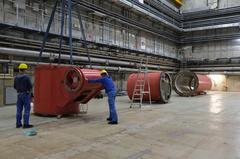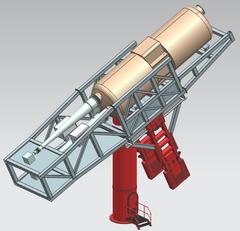URL: https://www.desy.de/news/news_search/index_eng.html
Breadcrumb Navigation
DESY News: A solar telescope in search of dark matter
News
News from the DESY research centre
A solar telescope in search of dark matter
If there was a physics most-wanted list, dark matter would be at the very top of it. Scientists all over the world use different approaches, experiments and methods to track it down. And DESY will soon run several experiments looking for dark matter particles. One of them is being set up in an underground hall at the HERA accelerator, and the first components have just arrived.

They're here! First components for the BabyIAXO helioscope arrive at DESY. Image: DESY
Axions are shy little things that have been predicted by theory but have not yet been observed by any experiment. They belong to a family of particles called WISPs ("weakly interacting sub-eV particles"), all of which are characterised by their tiny mass and their reluctance to interact with other particles and forces. Theory predicts that they sometimes transform into normal light particles that can be detected with sophisticated measuring methods, but only in an extremely strong magnetic field.
So if a light particle suddenly appears in a strong magnetic field where none should be, this could be an indication of an axion. Both ALPS II and BabyIAXO rely on this special property. But while ALPS II generates the axions itself and sends them through an opaque wall, BabyIAXO turns its gaze to the center of the Sun, from which, according to theory, axions should rain down on us all the time.
This requires a great deal of technology. First of all, you need a strong, long magnet with a large aperture. The magnet is currently being developed at CERN and the first components are already being tested. BabyIAXO will be about four times more powerful than the previous experiment "CAST" at CERN. The sensitivity of the proposed large IAXO would again be five times higher.
The detectors that capture the light particles must be extremely sensitive and noise-free. Several groups in Spain, France and Germany are preparing detectors for this task. The light generated in the magnet needs to be focused on the smallest possible area, similar to that in satellite X-ray telescopes. The collaboration partners involved in BabyIAXO from the USA, Italy and Denmark are also developing such telescopes in cooperation with the European Space Agency (ESA) and NASA in the US.The third large component is the rotating tower, which carries the entire 90-ton-weight. It must be stable enough for the solar telescope to be able to rotate around 360 degrees and track the centre of the Sun. BabyIAXO must always face the centre of the Sun very precisely, which will be no easy feat, given that it is located in an underground hall. Towers with a rotating device that fulfil such conditions are often used in astronomy for telescopes, and BabyIAXO's tower indeed had a previous life as a prototype carrier: it comes from Berlin Adlershof, where it held a telescope prototype for the Cherenkov Telescope Array project, in which DESY Zeuthen is a major participant. The studies made with this prototype are now complete and the tower was recycled for BabyIAXO.
There are several other examples of scientific recycling at BabyIAXO. This includes the hall of the HERA collider and the focusing system inside the magnets, which was supplied by ESA. ESA had built it as a spare part for an X-ray satellite called XMM-Newton, the largest science satellite ever built in Europe, and is lending it to the BabyIAXO team. The magnet developers also use existing tools from the magnet group of the ATLAS experiment at CERN for the new project.
“Of course we all eagerly await the results that BabyIAXO – and hopefully IAXO – will one day bring,” says Joachim Mnich, research director for particle physics research at DESY. “But already the inventive methods and ideas with which the experiment is designed and built as efficiently and cost-effectively as possible are fascinating. I am very pleased that BabyIAXO has been excellently evaluated in all scientific committees and that the experiment is now being set up here in Hamburg.”
The next step will be to adapt the support structure to its new function and set it up in the hall in the middle of next year. We will continue to report on the small and big adventures and challenges involved in setting up a completely new experiment.
Scientists are looking for dark matter because its nature is one of the greatest mysteries of physics. Observations and calculations of the motion of stars in galaxies show that there must be more matter in the universe than we can explain with the particles of matter we know today. In fact, dark matter should account for 85% of all matter in the universe. However, we do not know at present what the components of dark matter are, but we do know that it does not interact with normal matter and is essentially invisible, hence the term “dark”.




